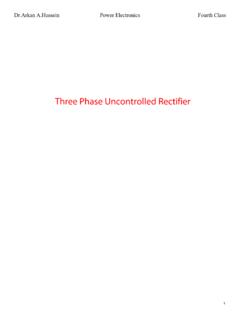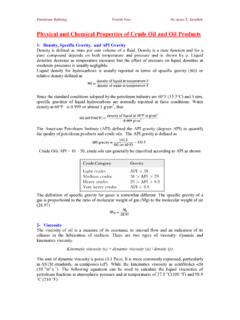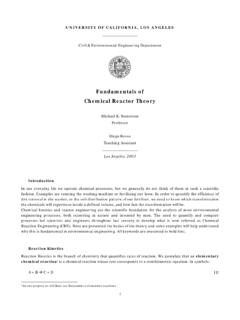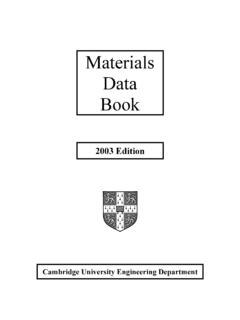Transcription of Mass Transfer - ceng.tu.edu.iq
1 Tikrit University Chemical Engineering Department Mass Transfer Third Year By Assist. Prof. Dr. Ahmed Daham Mass Transfer Third Year Assist. Prof. Dr. Ahmed Daham 2 Title: Mass Transfer Course Instructor: Assist. Prof. Dr. Ahmed Daham Wiheeb Textbook: 1. Coulson & Richardson , Chemical Engineering, Volume 1, six edition, ELBS, Pergamon Press. 2002. 2. Coulson & Richardson , Chemical Engineering, Volume 2, fifth edition, ELBS, Pergamon Press.
2 2002. References: 1. Treybal , Mass Transfer Operations, McGraw Hill 2. McCabe , Smith & Harriott P., Unit Operations in Chemical Engineering, McGraw Hill. 3. Seader Henley , Separation Process Principles. 4. Rousseau , Handbook of Separation Process Technology, John Wiley 5. Foust et al, Principles of Unit Operations, John Wiley Course description: This course covers the fundamentals of the basic concepts of mass transport and understanding about diffusion theory, gas absorption, liquid-liquid extraction, leaching , distillation, humidification, drying and evaporation.
3 Objectives: To give the students a application of diffusion theory to simple mass Transfer problems. Analysis of chemical engineering unit operations involving mass Transfer . Design principles for mass Transfer equipment. Solids/Liquids separation processes. liquids/Liquids separation processes. gases/Liquids separation processes. Grading: No. Assessment Number % each % total Dates 1 Homework (HW), Quizzes(Q) 10 % 10 2 Test 1 1 % 3 Test 2 1 % 4 Test 3 1 % 5 Test 4 1 % 6 Final Exam (F) 1 60 % 60 Overall Total 100 Mass Transfer Third Year Assist.
4 Prof. Dr. Ahmed Daham 3 Syllabus: No Topic Hours 1 diffusion , flick's law, modes of diffusion 4 2 Multi-components mixture, correction of diffusivity 4 3 diffusion in varying cross section area 4 4 Diffusivity coefficient in liquid and gas 2 5 Mass Transfer theory 2 6 Mass Transfer coefficient, wetted wall column 4 7 Absorption, equilibrium of gas and liquid 4 8 Packed tower 6 9 Tray tower 6 10 Calculation of tower diameter, stripping 2 11 Extraction , differential type 4 12 Completely immiscible 4 13 Party miscible 4 14 Leaching.
5 Batch leaching 4 15 Continuous leaching, constant under flow 4 16 Continuous leaching, variable under flow 4 17 Distillation , vapor-liquid equilibrium 4 18 Differential type 2 19 flash distillation 2 20 Continuous distillation (binary system) 6 21 Calculation the number of stages and reflux ration in continuous distillation 4 22 Multi-feeds and side stream , lewis sorial method 6 23 Ponchon-savarit method 4 24 Batch distillation with constant reflux ratio 6 and with constant product composition 25 Multi-component distillation 4 26 Humidification , humidity 2 27 Cooling tower calculation 2 28 Height of cooling tower, carey method 4 29 Drying process 6 30 Evaporation 4 Mass Transfer Third Year Assist.
6 Prof. Dr. Ahmed Daham 4 Chapter (10) in Volume (1) (( diffusion )) The term diffusion (mass Transfer ) is used to denote the transference of a component in a mixture from a region where its concentration is high to a region where the concentration is lower. diffusion process can take place in a gas or vapour or in a liquid, and it can result from the random velocities of the molecules (molecular diffusion ) or from the circulating or eddy currents present in a turbulent fluid (eddy diffusion ). diffusion depends on: 1. Driving force ( C), moles per unit volume (kmol/m3).
7 2. The distance in the direction of Transfer ( z), meter (m). 3. Diffusivity coefficient, unit area per unit time (m2/s). fick 's Law of diffusion : The rate of diffusion is governed by fick 's Law, first proposed by fick in 1855 which expresses the mass Transfer rate as a linear function of the molar concentration gradient. In a mixture of two gases A and B, assumed ideal, fick 's Law for steady state diffusion may be written as: Mass Transfer Third Year Assist.
8 Prof. Dr. Ahmed Daham 5 JA CA z JA= DAB dCAdz .. fick s first law of steady state diffusion Where: JA: is the molecular diffusion flux of A , (moles per unit area per unit time) . CA: is the concentration of A (moles of A per unit volume) kmolm3 . DAB: is known as the diffusivity or diffusion coefficient for A in B (unit area per unit time) m2s z: is distance in the direction of Transfer (m). diffusion with bulk of mass in motion: The fick 's first law of diffusion describes the mass Transfer from the random movement of molecules of a stationary medium or a fluid in streamline flow.
9 If circulating currents or eddies are present, then the molecular mechanism will be reinforced and the total mass Transfer rate may be written as: Total diffusion = Molecular diffusion + Convection term Convection term = Eddy diffusion = Molar flux due to convection Convection term = Concentration * mass Transfer velocity = CA . V Where: = = + = . = Total diffusion = NA = JA + CA . V = + + ..( ) Total diffusion equation in the form of concentration (normally used for liquids) Mass Transfer Third Year Assist.
10 Prof. Dr. Ahmed Daham 6 The total diffusion equation can be write in another forms: a. Partial pressure for gases. b. Mole fraction for gases and liquids. a. Total diffusion equation in the partial pressure form: If A and B are ideal gases in a mixture, the ideal gas law may be applied to each gas separately and to the mixture: P V=n R T P =n V R T P =C R T PA =CA R T and PT =CT R T CA=PAR T dCA=1R T dPA = + + ..( ) Total diffusion equation in the form of partial pressure (normally used for gases) b.







